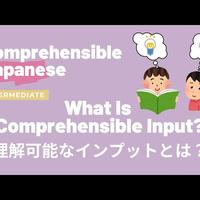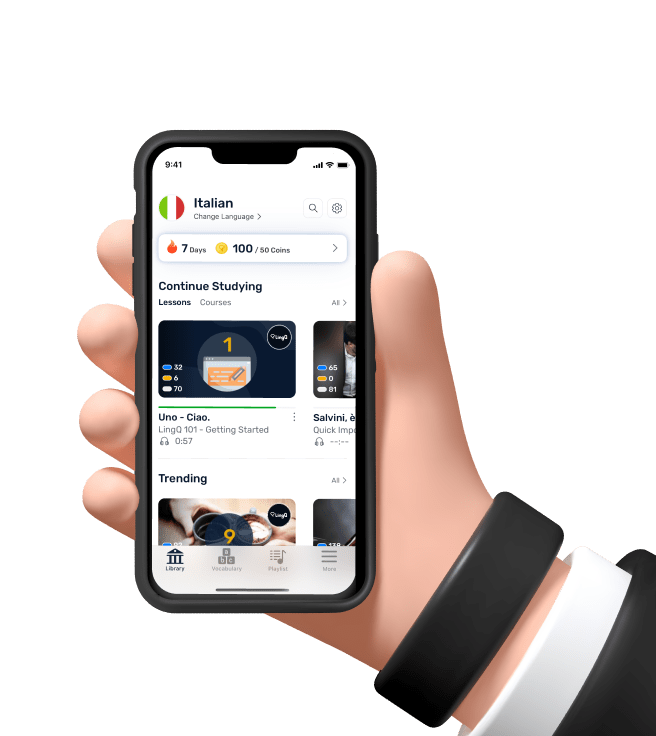What Is Comprehensible Input ? "理解 可能な インプット "と は ? - Intermediate Japanese 日本 語 中級
what|is|comprehensible|input|りかい|かのうな||||intermediate|japanese|にっぽん|ご|ちゅうきゅう
Was ist verständlicher Input? Was ist verständlicher Input? - Japanisch für Fortgeschrittene
What Is Comprehensible Input ? What Is Comprehensible Input ? - Intermediate Japanese
Qu'est-ce que l'input compréhensible ? Qu'est-ce qu'un input compréhensible ? - Japonais intermédiaire
O que é um input compreensível? O que é um input compreensível? - Japonês intermédio
什么是可理解性输入? 什么是可理解性输入? - 中级日语
この チャンネル の 名前 は Comprehensible Japanese と いいます
|ちゃんねる||なまえ||comprehensible|japanese||いい ます
The name of this channel is Comprehensible Japanese.
该频道的名称是 "可理解的日语"。
私 は 世界中 で 日本 語 を 学ぶ 皆さん に 日本 語 の Comprehensible Input
わたくし||せかいじゅう||にっぽん|ご||まなぶ|みなさん||にっぽん|ご||comprehensible|input
I am a Comprehensible Input for Japanese to all of you who are learning Japanese around the world.
我为世界各地学习日语的学生提供日语理解性输入。
つまり " 理解 可能 の インプット " を 提供 する ため に 動画 を 作って います
|りかい|かのう||||ていきょう||||どうが||つくって|い ます
In other words , I make videos to provide " comprehensible input "
换句话说,我们制作视频是为了提供 "可理解的输入"。
今回 の 中級 動画 で は " 理解 可能な インプット " と は 何 か に ついて 解説 し たい と 思い ます
こんかい||ちゅうきゅう|どうが|||りかい|かのうな||||なん||||かいせつ||||おもい|
在这段中级视频中,我们将讨论什么是可理解的输入。
スティーブンクラッシェン と いう アメリカ の 有名な 言語 学者 が い ます
|||あめりか||ゆうめいな|げんご|がくしゃ|||
美国有一位著名的语言学家,名叫史蒂文-克拉申(Steven Krashen)。
言語 の 研究 を して いる 人 です 彼 が 「 言語 を 身 に つける ため に は
げんご||けんきゅう||||じん||かれ||げんご||み|||||
He's a language researcher, and he says, "To learn a language, you have to be able to speak it.
他是一名语言研究员,他说:"要学习一门语言,你必须会说它。
理解 可能な インプット が 重要だ 」 と 主張 して い ます
りかい|かのうな|||じゅうようだ||しゅちょう|||
He insists, "It's all about comprehensible input.
他坚持认为,"可以理解的意见很重要"。
理解 可能 と は 理解 できる わかる と いう 意味 です ね
りかい|かのう|||りかい|||||いみ||
Understandable means understandable or comprehensible.
可理解的意思是可以理解、可以理解、可以理解。
そして インプット と は 読んだり 聞いたり する こと です
||||よんだり|きいたり|||
我所说的 "输入 "是指阅读和聆听。
クラッシェン 博士 は 「 言語 の " 学習 " と 言語 の " 習得 " は 違う 」 と 言って い ます
|はかせ||げんご||がくしゅう||げんご||しゅうとく||ちがう||いって||
Dr. Krashen says that "learning a language is not the same as acquiring a language."
克拉申博士说,"学习一门语言并不等于掌握一门语言"。
学習 と は 文法 の ルール を 学んだり 単語 を 暗記 したり と 頭 を 使って 意識 的に 勉強 する こと です
がくしゅう|||ぶんぽう||るーる||まなんだり|たんご||あんき|||あたま||つかって|いしき|てきに|べんきょう|||
Learning is a conscious effort to use one's mind to study, to learn grammar rules, to memorize words, etc.
学习是指有意识地运用大脑进行学习,例如学习语法规则或记忆词汇。
一方 習得 と は 、 例えば 日本 人 の 子供 が 日本 語 を 身 に つける とき の ように
いっぽう|しゅうとく|||たとえば|にっぽん|じん||こども||にっぽん|ご||み|||||
Acquisition, on the other hand, is the process of learning a language, such as when a Japanese child learns Japanese.
另一方面,习得是学习语言的过程,例如日本儿童学习日语的过程。
たくさん たくさん 聞いて インプット を して 意識 的に 勉強 して で は なく 自然に 身 に つける こと です
||きいて||||いしき|てきに|べんきょう|||||しぜんに|み||||
Listen a lot, listen to a lot, and input a lot, so that it becomes second nature to you, rather than something you consciously study.
多听、多听、多输入,自然而然地学习,而不是有意识地学习。
そして クラッシェン 博士 は こちら が 重要だ と 言って い ます 言語 学 者 の 中 に は
||はかせ||||じゅうようだ||いって|||げんご|まな|もの||なか||
And Dr. Krashen says it's important that some linguists
克拉申博士说,值得注意的是,一些语言学家对此并不十分肯定。
これ は 子ども だけ が できる こと で 、 大人 に は でき ない 大人 に は 無理だ と 言う 人 も い ます
||こども||||||おとな|||||おとな|||むりだ||いう|じん|||
Some people say that this is something that only children can do, but not adults, and that adults cannot do it.
有人说,只有孩子能做到这一点,成年人却不行,成年人做不到这一点。
ですが クラッシェン 博士 は この " 理解 可能な インプット " を たくさん すれば 大人 に も できる と 言って い ます
||はかせ|||りかい|かのうな|||||おとな|||||いって||
但克拉申博士说,只要多加理解,成年人也能做到这一点。
つまり 自分 が 理解 できる レベル の もの を 大量に 読んだり 聞いたり すれば 大人 でも 子供 と 同じ ように
|じぶん||りかい||れべる||||たいりょうに|よんだり|きいたり||おとな||こども||おなじ|
In other words, if you read or listen to a large amount of material at a level you can understand, you will find that adults can understand just as well as children.
换句话说,如果你以自己能够理解的水平阅读和聆听大量材料,你会发现成年人也能像孩子一样做到这一点。
意識 的な 勉強 で は なく 自然に
いしき|てきな|べんきょう||||しぜんに
不是有意识地学习,而是自然而然地学习。
外国 語 を 身 に つけ られる と 主張 して い ます 理解 可能 と いって も 100%
がいこく|ご||み|||||しゅちょう||||りかい|かのう|||
They claim to be able to learn a foreign language, even though it is 100% understandable.
声称能够 100% 地学会一门外语,即使是在听得懂的情况下。
全て の 単語 や 文法 が わかる 必要 は あり ませ ん 100% で は なくて 、 ほぼ 理解 できる と いう の が 大切です
すべて||たんご||ぶんぽう|||ひつよう|||||||||りかい||||||たいせつです
You don't need to know every word and grammar, but you should be able to understand most of it, not 100%.
您不需要知道所有的单词和语法,但重要的是能够理解其中的大部分内容,而不是 100%。
これ は 日本 語 を 勉強 中 の ジョン さん です 例えば 私 が 「 昨日 電車 で 学校 に 行き ました 」 と 言った と し ます
||にっぽん|ご||べんきょう|なか||じょん|||たとえば|わたくし||きのう|でんしゃ||がっこう||いき|||いった|||
This is John, who is studying Japanese. For example, let's say I say, "I took the train to school yesterday.
例如,我说:"昨天我坐火车去学校"。
ジョン さん は 昨日 、 で 、
じょん|||きのう|
John was in yesterday,
学校 、 に 、 行き ました この 部分 は
がっこう||いき|||ぶぶん|
すでに もう 分かり ます もう 習得 して い ます
||わかり|||しゅうとく|||
I already know it, I already know it, I already know it, I already know it.
" 電車 " と いう 単語 だけ が
でんしゃ|||たんご||
The word "train" is the only word that comes to mind.
分かり ませ ん 分から なかった と し ます
わかり|||わから||||
I don't understand I don't understand
そこ で 私 が 電車 の 絵 を 書いて 「 昨日 電車 で 学校 に 行き ました 」 と 言い ます
||わたくし||でんしゃ||え||かいて|きのう|でんしゃ||がっこう||いき|||いい|
Then I draw a picture of a train and say, "I took the train to school yesterday."
そう する と ジョン さん は 全体 の 意味 が 理解 でき ます ね そして 知ら なかった 電車 と いう 単語 が 新たに 習得 さ れ ます
|||じょん|||ぜんたい||いみ||りかい|||||しら||でんしゃ|||たんご||あらたに|しゅうとく|||
And then John will understand the meaning of the whole thing, and he'll learn a new word that he didn't know before: train.
ほとんど の 部分 は 理解 できる もう 習得 して いる けれど
||ぶぶん||りかい|||しゅうとく|||
I can understand most parts of it, although I've already mastered a few things.
少し だけ 、 一部分 だけ まだ 習得 して い ない 単語 や 文法 が 含ま れた 文 を
すこし||いちぶぶん|||しゅうとく||||たんご||ぶんぽう||ふくま||ぶん|
If you are only interested in a small portion of a sentence that contains words or grammar you have not yet mastered, please contact us.
たくさん 、 大量に 繰り返し 読んだり 聞いたり する こと で
|たいりょうに|くりかえし|よんだり|きいたり|||
By reading and listening to a lot of repetitive, repeated reading and listening
ちょっと ずつ ちょっと ずつ 言葉 が 身 に ついていき ます
||||ことば||み|||
Little by little, the language is being learned.
クラッシェン 博士 は これ を " i +1" と 呼んで い ます 例えば ジョン さん の 今 の 日本 語 力
|はかせ||||||よんで|||たとえば|じょん|||いま||にっぽん|ご|ちから
Dr. Krashen calls it "i +1." For example, John's current Japanese language ability is "i +1.
現在 の 日本 語 レベル が これ くらい だ と し ます 今 現在 の 日本 語 力 を " i " と し ます
げんざい||にっぽん|ご|れべる||||||||いま|げんざい||にっぽん|ご|ちから|||||
Let's say your current level of Japanese is about this.
今 の 自分 の 日本 語 力 +1 つまり i +1 の
いま||じぶん||にっぽん|ご|ちから|||
Your current Japanese language ability + 1, i.e., i + 1.
インプット を 大量に する と
||たいりょうに||
When you have a lot of input
この +1 の 部分 が 習得 さ れ ます そして また 更に +1 の レベル の もの を たくさん 読んだり 聞いたり する こと で
||ぶぶん||しゅうとく||||||さらに||れべる|||||よんだり|きいたり|||
少しずつ 少しずつ 身 に ついていき ます これ が " 理解 可能な インプット " に よる 言語 習得 です
すこしずつ|すこしずつ|み||||||りかい|かのうな||||げんご|しゅうとく|
もう 一 つ 重要な の は 自分 に とって 面白い もの 、 興味 が ある もの を たくさん 読んだり 聞いたり する と いう こと です
|ひと||じゅうような|||じぶん|||おもしろい||きょうみ||||||よんだり|きいたり|||||
Another important thing is to read and listen to a lot of things that are interesting to you.
面白く ない もの 、 つまらない もの や 興味 の ない もの で は あまり 効果 が あり ませ ん
おもしろく||||||きょうみ|||||||こうか||||
If something is uninteresting, boring, or uninteresting, it will not be very effective.
" 外国 語 " と いう こと を 忘れて しまう くらい 楽しめる もの を 読んだり 聞いたり する こと が 大切だ と
がいこく|ご|||||わすれて|||たのしめる|||よんだり|きいたり||||たいせつだ|
It is important to read or listen to something that you enjoy so much that you forget that it is a foreign language.
クラッシェン 博士 は 言って い ます 私 も クラッシェン 博士 の 主張 に 賛成 です
|はかせ||いって|||わたくし|||はかせ||しゅちょう||さんせい|
Dr. Krashen says, and I agree with Dr. Krashen's assertion.
大 賛成 です な ので 今 こうして 理解 可能な 日本 語 の 動画 を 作って 皆さん に 提供 して い ます
だい|さんせい||||いま||りかい|かのうな|にっぽん|ご||どうが||つくって|みなさん||ていきょう|||
I agree with you very much, and that's why I'm making these understandable Japanese videos for you.
皆さん が 理解 できる ように 私 は ゆっくり
みなさん||りかい|||わたくし||
I'll take my time so that you can understand.
はっきり 話したり 絵 を 書いたり ジェスチャー を したり
|はなしたり|え||かいたり|||
難しい 言葉 は 簡単な 言葉 に 言い換えたり して い ます
むずかしい|ことば||かんたんな|ことば||いいかえたり|||
Difficult words are sometimes rephrased into simple words.
これ から も 皆さん に とって 理解 可能な 日本 語 の コンテンツ を もっと もっと 作る ので 楽しみに して いて ください
|||みなさん|||りかい|かのうな|にっぽん|ご||こんてんつ||||つくる||たのしみに|||
We look forward to creating more and more understandable Japanese content for you in the future.
今日 は 理解 可能な インプット と は 何 か に ついて 説明 し ました
きょう||りかい|かのうな||||なん||||せつめい||
Today we're going to talk about what constitutes understandable input.
今日 は これ で おしまい
きょう||||
また ね !

